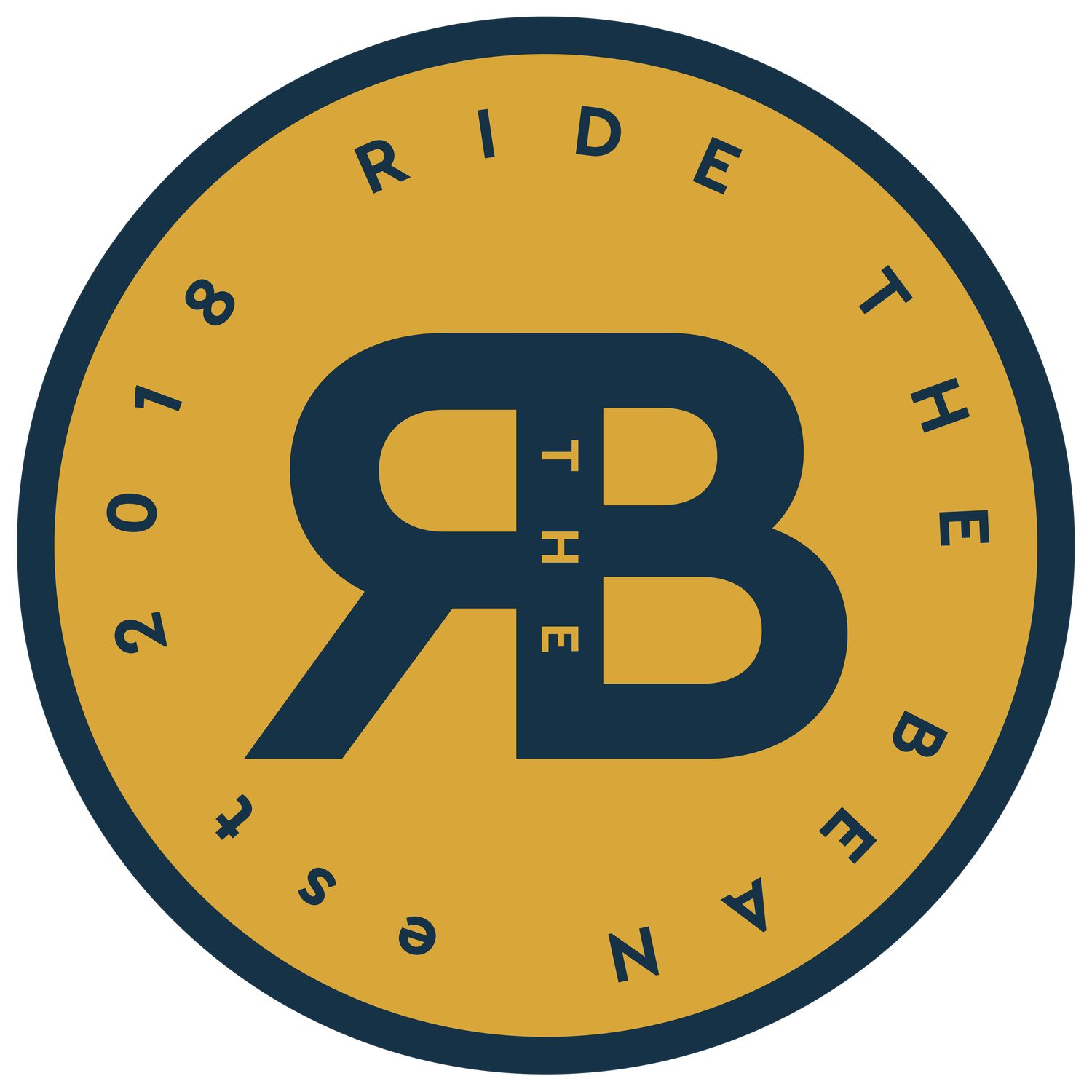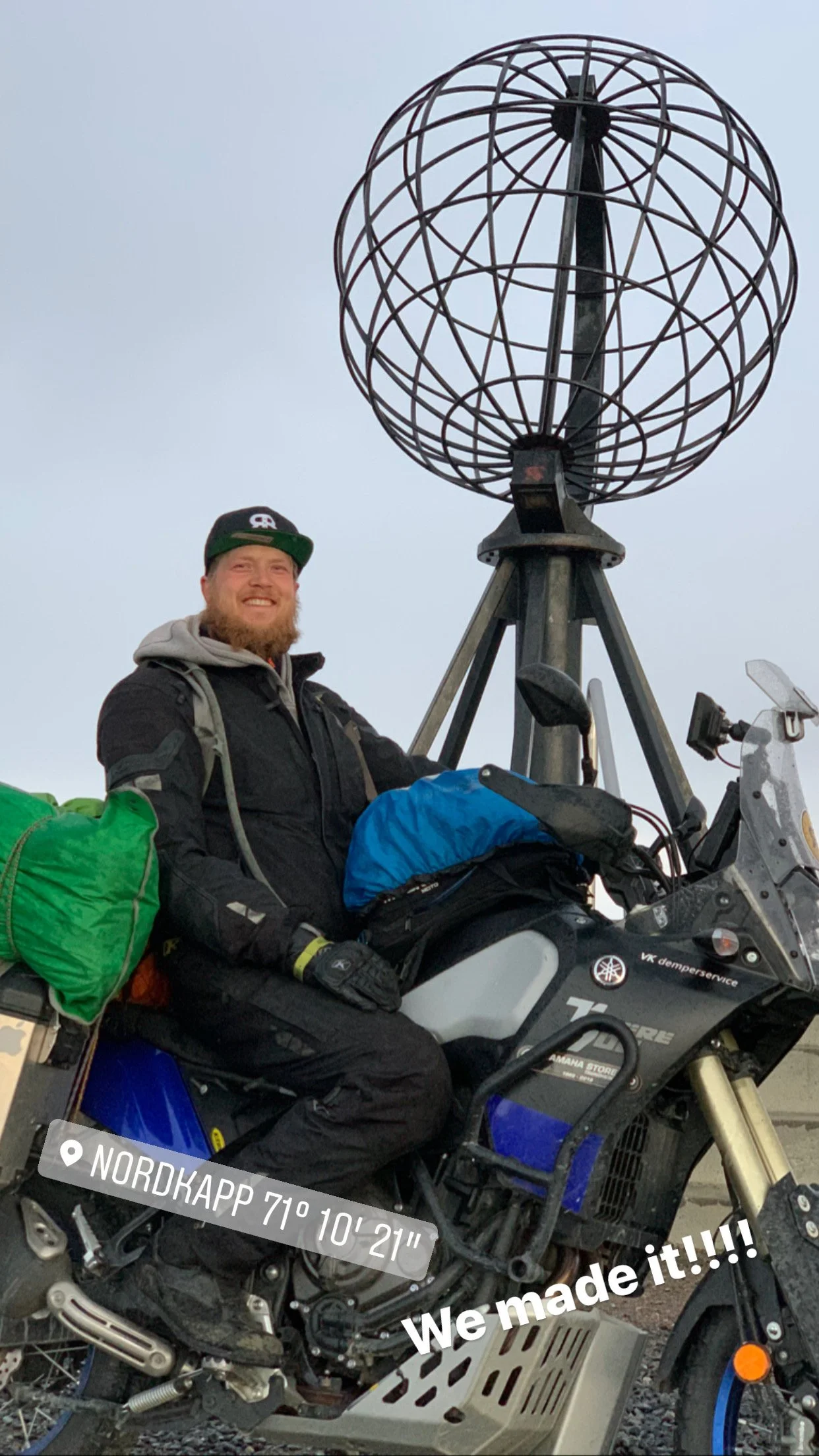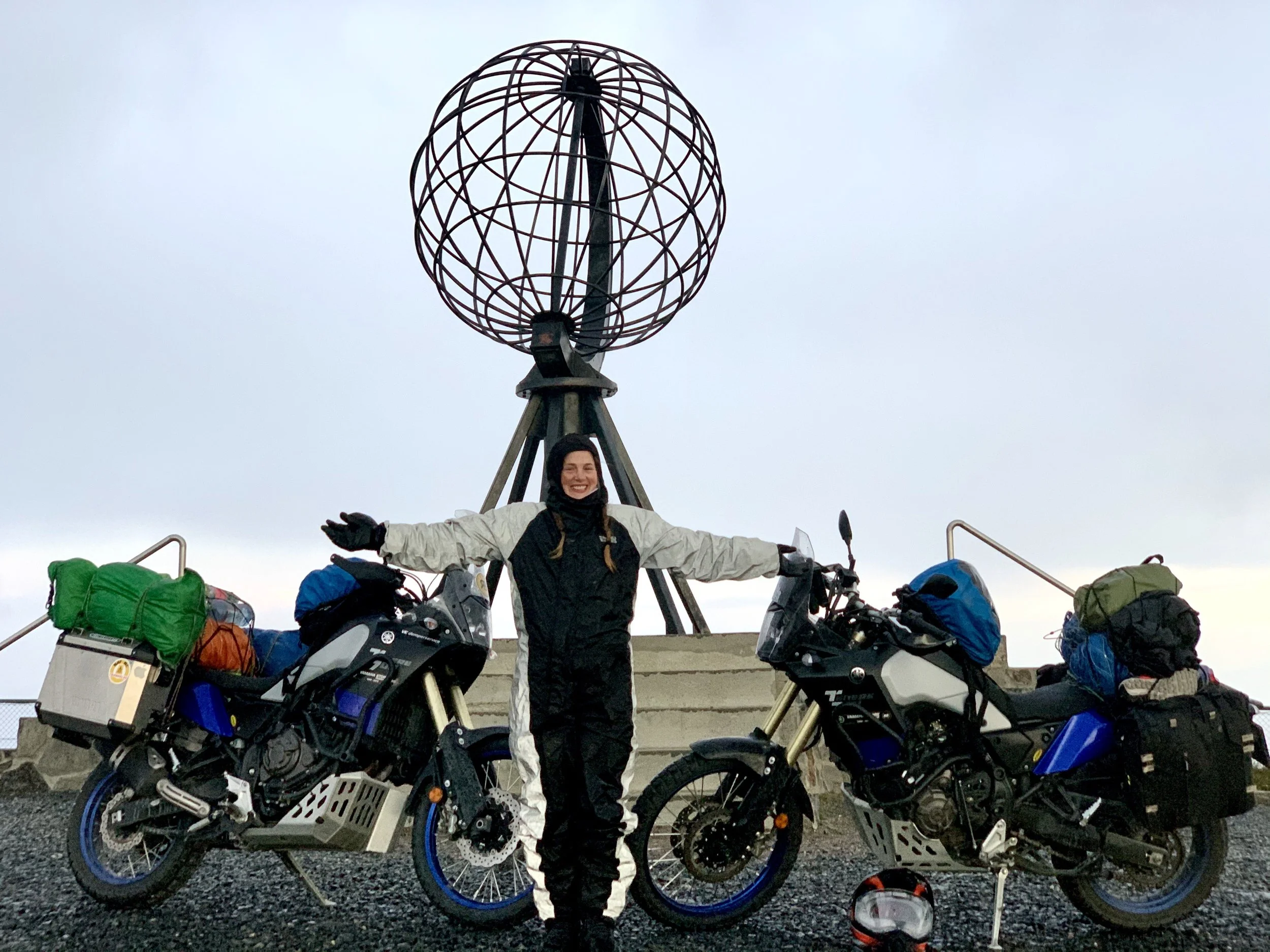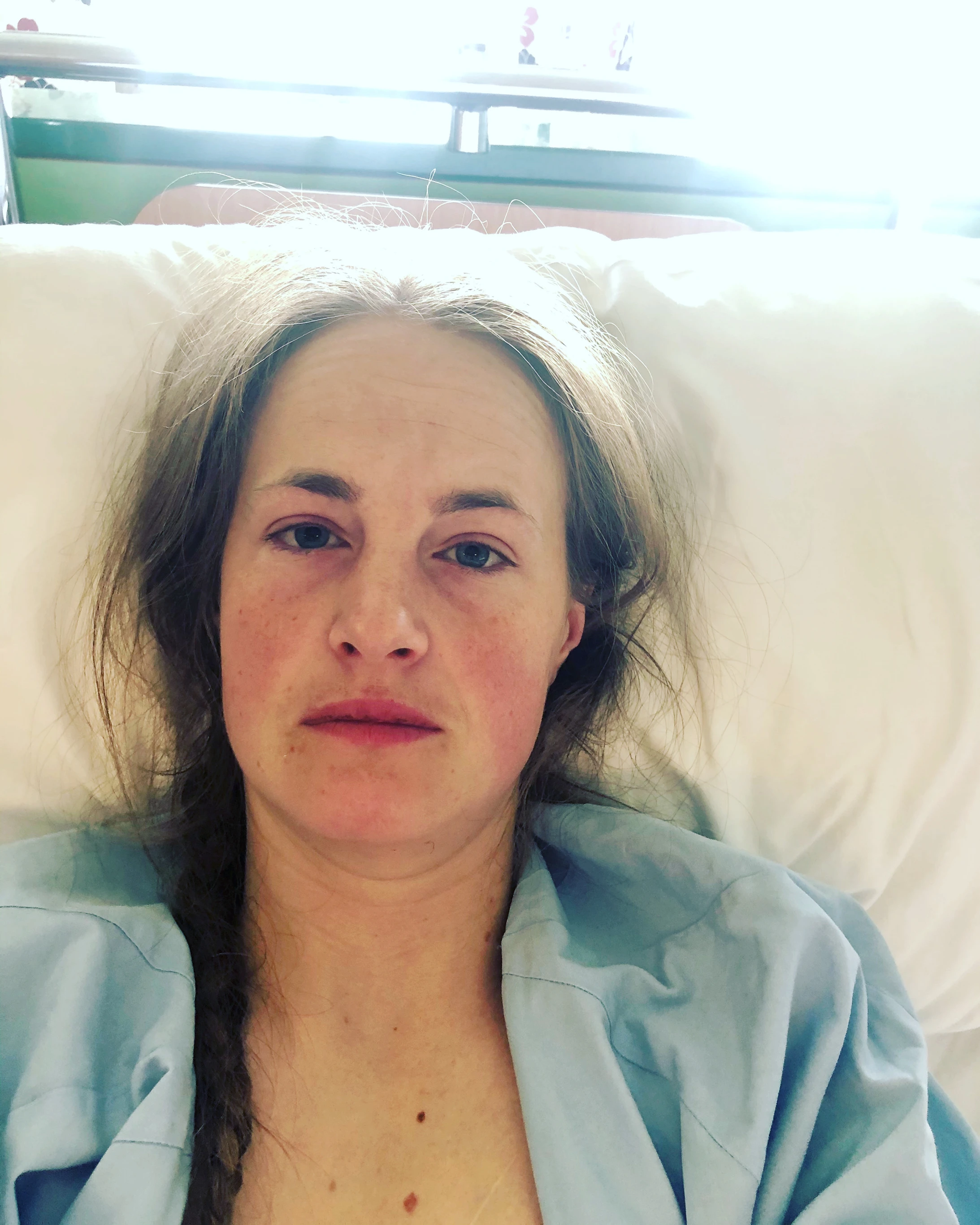Our best day ever turned into a nightmare in a split second! Part 1 of 2
Originally posted: Sep 21, 2020
It’s three o’clock when the alarm goes off. We don’t want to leave the warm sleeping bag, but we know our goal is worth it. The sky is a beautiful light pink and blue with wispy skies. We quickly pack down the tent, careful to hold it tight lest the wind carry it away across the mountain.
We hop on the bikes and ride north. Our aim is the northernmost part of the European mainland: the North Cape. It’s a mere 40 minutes ride away. As we ride out, the skies on our right side remain peaceful but on the left an ominous cloud appears, carrying rain. At four o’clock our goal is within sight. We ride under the open gate to the parking lot, then through some rocks toward the statue. The station is not manned yet, we are alone and sneak right before the monument. As we park the bikes the skies open up. “We should’ve been half an hour earlier!”
Finally at the north cape!
The rain doesn’t ruin the moment for us, as we pull out the camera. “This is the beginning of our journey!” Finally it’s time to start the ride we’ve been planning for two years. The ride that’s kept us hoping and dreaming, working extra and living frugally to save money.
Excitedly we ride on back south. Stopping every so often to admire the reindeer that are having their breakfast by the side of the road. We’re finally on our trip! We pull off toward a gravel road to ride the northernmost part of the TET. It looks promising for the first few hundred meters, until we reach a river crossing that just looks too hard for us. There’s a muddy, slippery hill that goes thump thump down into the river, and we can’t see a road on the other side. We don’t want to risk any damage to our bikes and turn around. It’s only the start of our journey! In Alta we discuss our plans for the next few days. The second northernmost part of the TET will lead us on a path that takes us through Finland and Sweden before we cross back into Norway. We long for a break from paved roads and are delighted for a gravel ride. We check corona restrictions with travel within these countries but we are none the wiser. We decide we'll camp on the Norwegian side of the border, and if we can pass into the Finland the day after, we will. If not, we will enjoy the ride back.
And what a gravel road it is! The views. The reindeer. The thrill of an uneven ground. Standing up on the bikes, riding through forests and open plains. Admiring the lakes. The luscious green leaves with patches of ripened yellow of the autumn still to come. The sun that glimmers through the trees. The uneven ground makes the perfect test for our new suspension. I can feel the bike bounce up and down wonderfully on the sandy and rocky surface. Even with the bikes fully loaded they suspend beautifully.
We cross a paved road and a new gravel road appears. The view is not so spectacular but the road is more even, with the occasional pointy rock. Some parts are muddy but we ride through effortlessly, all the training we’ve put in encouraging us forward. I feel safe, I feel confident. I feel in control of the bike.
As we ride along, suddenly the ground disappears beneath us and is replaced by darkness before the front wheel hits a rock wall. I fall. Kenneth´s voice in my helmet: “what??” Bang. We’re both in the river.
Dead man’s button! Ignition off! I worry about the engines of the motorcycles being flooded by water. I hop over to Kenneth´s bike and do the same on his. Should the engine get flooded, we have to remove the spark plug and getting to it requires us to remove the gas tank. We wouldn’t find camp for hours if that happened.
“Okay, what now?” I ask Kenneth. “I’ve switched the dead man´s button and switched the ignition off. What else do I have to do?” No response. Kenneth is huddled between the two bikes, hands on his knees. I walk towards him and realize he’s struggling to draw breath properly. I feel a sudden rush of pain in my lower back and realize we’ve been in an accident. Wait. Accident. Motorcycles. Stone wall. High energy trauma.
We need help. I have no idea where we are, so I pick up my phone and get the app I’m so thankful for: Hjelp 113. If you call emergency services through that app, it will send them the coordinates of where you are. It opens up, sigh of relief. Minutes save lives and in this instance knowing our location could mean the difference between life and death. I never wanted to need this. Press the 113 button. The phone blacks out. No!!!
I get Kenneths phone from his pocket. Now I have to explain to them where we are. “Hello my name is Pia I’m a nurse we’re somewhere in Finnmark!” I feel so silly saying that. Finnmark is an old county that measures 48 618 square kilometer. I feel desperate. “Between Alta and Kautokeino!” Then it dawns on me to get the gps to find the coordinates.
113 on speaker phone. Kenneths pain is increasing. His lips are turning blue. “I’m not gonna survive this” he says, “I’m not good. I could feel something break inside me. It’s so painful.” I tell him he looks fine, he’ll be okay, he looks good. In my head is the image of my past patients who have been seriously ill, and he looks fine. He’s probably just scared. He’s fine. We’re gonna be fine. Helicopter is heading our way thanks to us finding the coordinates.
So how will the helicopter see us when it arrives? I get my sleeping bag, cover Kenneth with it, it’s bright blue. That will be my flag. I will wave it and they will see us. They are on their way. Kenneth is forbidden to speak or move, he must save his energy for breathing.
Somebody’s coming! Two ATVs on the horizon. I wave and yell and hope they don’t fall in too. As they approach I recognize their police uniforms. I tell the first man four times that the ambulance is on its way and Kenneth is not allowed to speak. He asks if I have notified the ambulance. The second police man comes by our side and keeps asking Kenneth questions. I tell him the ambulance helicopter is coming to pick us up and Kenneth is not to speak as per instructions from 113. He asks if we have notified ambulance. “There’s no bridge here,” they say, “it’s been gone for years. The flood took it!” They offer us jackets for warmth and it soothes my shivering. I notice I’m shivering.
Helicopter arrives. Anesthesiologist tends to Kenneth. I get out of the way. I’m driven to ambulance by policeman on ATV. Kenneth is put on stretcher and carried. Anesthesiologist gives him a gas to relieve his pain. He’s pulled in and quickly goes into a half wake-half sleep state. The anesthesiologist cares for him while another man, also named Kenneth, gets my vitals and checks me up. They are calm and smile and tell me everything will be okay.
As we land at the airport, Kenneth is pulled out of the helicopter on the gurney and transferred to a waiting ambulance. He looks at me while they carry him out and I tell him he looks good. “You don’t look great, but you don’t look like a dead fish either!”
I walk from helicopter to ambulance. Take my motorcycle pants off in there, so they won’t be cut off me in the trauma room. I walk from ambulance to trauma room. Place my shivering self on a bench. From every side of me a person appears. I’m covered in warm blankets and two ladies take my clothes off. A kind face presents itself and explains his or her purpose. I’m pricked and prodded, examined every which way. I’m turned to my side, doctor says he’ll take a look at my bum, but fails to mention he’ll look with his finger. I jerk as his finger shoots up my bum without warning.
In the next room is Kenneth. His well-being is my first concern. I know he’s going through the same procedure as me, only more intense as his injuries are considered worse. The anesthesiologist from the helicopter walks in and tells me he’s doing okay, but pissed off that they cut his hoodie open with scissors. I sigh in relief. If that’s his biggest concern right now he can’t be that bad. For a split second there I felt concerned that my last words to him were “you don’t look like a dead fish”. Now I smile in relief.
I’m moved to a bed, to the CT bench, back to bed. I’m usually the person moving other people but now I’m the one being moved. I’m wheeled around the hospital and as I’m brought to a stop, I’m told I’m in intensive care. My head is about to burst with pain and my eyes can’t take any light. The nurse gives me a towel to wrap around my eyes to ward it off. I try to use it as an instrument to shut out the entire experience, the pain, the memory of the ground falling beneath me, the fear I hold for my significant other’s life.
To my left and right are curtains. I’m settled and then left alone as another patient arrives by my right side. I hear the anesthesiologist and nurse discuss what should be done. The words Tromsø and operation are mumbled. I hear drugs being controlled, math equations, vital signs being called out. I hear the nurse try to explain something to the patient, and a familiar voice curse back in frustration. I hear my name. “Where’s Pia?! No I don’t want oxygen!” Everything is not okay. He is not okay.
Silence. I lift my blanket, shift my legs to the far right of the bed, lift up the plastic rectangular container that displays the amount of urine my body produces per hour. Hop out of the bed, pull away the curtain that separates the two of us, meant to be following each other on bikes - not laying in hospital beds. He’s resting now, apparently. But his body is not; the equipment monitoring his body show a high pulse and low blood pressure. As I gently whisper his name and his eyes jerk open the rhythm of his heart jumps into another gear. He’s in trouble. I tell him I’m fond of him, we’ll get through this together somehow. We’re team Ride the Bean.
Every hour, my nurse comes to my side to wake me up. I´m asked where I am, who I am. I am given 15 of 15 points of the Glasgow Coma Scale that I am so familiar with. She shines a light in my eyes, to see if my pupils retract to light. She measures my blood pressure, writes my pulse into a flow chart. This is my job. I´m usually the one filling out the flow chart, making sure there´s no brain hemorrhage, neurological deficit or cognitive impairment. Now I´m the one being tested.
“I’m so sorry, but I think you’re standing in my urine.” It’s the day after. We’re in intensive care, but I’m not the one in a uniform. My nurse has come to fetch me, helped me out of bed. In the chaos of wires hooked to my body the plastic case holding my urine has been disconnected from the catheter itself, and urine has spilled on the floor. “Don’t worry, I’ll get that”, she says, which is exactly what I’ve said to my patients in similar situations. In lieu of a shirt my upper body is covered in a protective gown used by nurses while caring for patients. I feel as though I’ve been split in three. Nurse. Patient. Next of kin. My sense of familiarity with my surroundings, and need to fix problems around me remind me of my profession as a nurse. Strongly emphasized by wearing part of a nurse´s uniform. The constant pain in my back, the dizziness in my head, the urine catheter I carry in my hands tell another story though. The patients´ pants I wear feel like restraints holding me back from where my heart lies. I long to be with my man, the one I’ve created a homeless home with. The one who’s in the next room stuck in limbo between one surgery and the next.
-Pia





